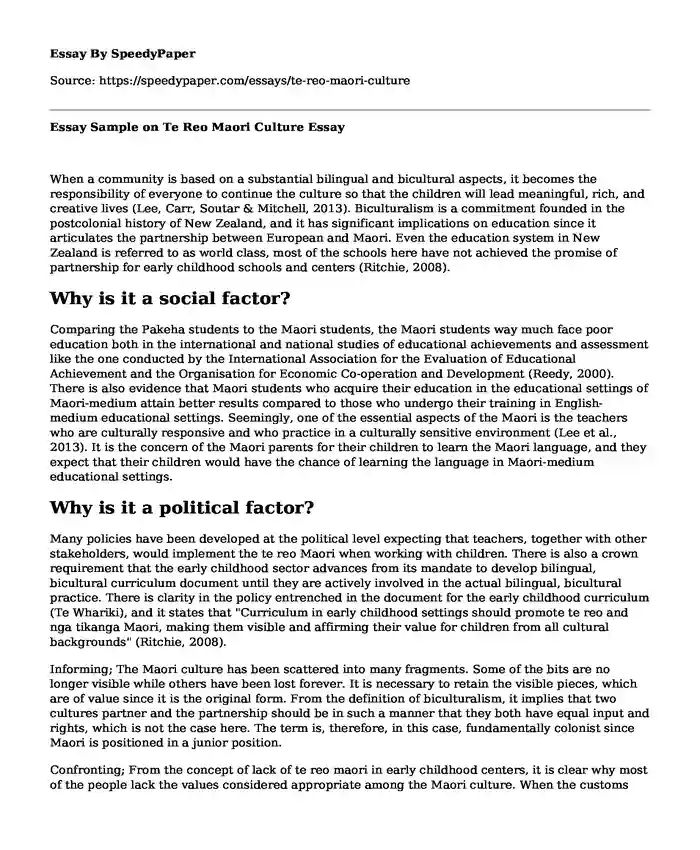
| Type of paper: | Report |
| Categories: | Teaching Race Learning Students Languages Multiculturalism |
| Pages: | 3 |
| Wordcount: | 737 words |
When a community is based on a substantial bilingual and bicultural aspects, it becomes the responsibility of everyone to continue the culture so that the children will lead meaningful, rich, and creative lives (Lee, Carr, Soutar & Mitchell, 2013). Biculturalism is a commitment founded in the postcolonial history of New Zealand, and it has significant implications on education since it articulates the partnership between European and Maori. Even the education system in New Zealand is referred to as world class, most of the schools here have not achieved the promise of partnership for early childhood schools and centers (Ritchie, 2008).
Why is it a social factor?
Comparing the Pakeha students to the Maori students, the Maori students way much face poor education both in the international and national studies of educational achievements and assessment like the one conducted by the International Association for the Evaluation of Educational Achievement and the Organisation for Economic Co-operation and Development (Reedy, 2000). There is also evidence that Maori students who acquire their education in the educational settings of Maori-medium attain better results compared to those who undergo their training in English- medium educational settings. Seemingly, one of the essential aspects of the Maori is the teachers who are culturally responsive and who practice in a culturally sensitive environment (Lee et al., 2013). It is the concern of the Maori parents for their children to learn the Maori language, and they expect that their children would have the chance of learning the language in Maori-medium educational settings.
Why is it a political factor?
Many policies have been developed at the political level expecting that teachers, together with other stakeholders, would implement the te reo Maori when working with children. There is also a crown requirement that the early childhood sector advances from its mandate to develop bilingual, bicultural curriculum document until they are actively involved in the actual bilingual, bicultural practice. There is clarity in the policy entrenched in the document for the early childhood curriculum (Te Whariki), and it states that "Curriculum in early childhood settings should promote te reo and nga tikanga Maori, making them visible and affirming their value for children from all cultural backgrounds" (Ritchie, 2008).
Informing; The Maori culture has been scattered into many fragments. Some of the bits are no longer visible while others have been lost forever. It is necessary to retain the visible pieces, which are of value since it is the original form. From the definition of biculturalism, it implies that two cultures partner and the partnership should be in such a manner that they both have equal input and rights, which is not the case here. The term is, therefore, in this case, fundamentally colonist since Maori is positioned in a junior position.
Confronting; From the concept of lack of te reo maori in early childhood centers, it is clear why most of the people lack the values considered appropriate among the Maori culture. When the customs are not taught to a younger generation, then some values are not passed to them hence making them lack the necessary values as is the case with the current generation (Ritchie & Rau, 2006). During the days when the Maori culture was taught in the schools, the children raised had better values and characters than the children of the current generation who do not have that knowledge.
Reconstructing; To bring things back on track, there is a need to educate the younger generation on the Maori culture by reintroducing the te reo Maori back into the early childhood children centers. There is a need for the two cultures to negotiate and agree on reintroducing the teaching of the Maori language in early childhood centers.
References
Lee, W., Carr, M., Soutar, B., & Mitchell, L. (2013). Understanding the Te Whariki approach: Early years education in practice. Routledge. https://www.taylorfrancis.com/books/9781135119737
Reedy, T. (2000). Te Reo Maori: The past 20 years and looking forward. Oceanic Linguistics, 157-169. https://www.jstor.org/stable/3623221?casa_token=EM-nToVag9kAAAAA:ADxh4Kq2j5JUljqU0IhisIbKpBwrsAds33DaEJ3_Bo7I2qmmMW7K3NqvbBBWViScKqQQku6PmxLd5mqzIETijdRKEee9_P02o_EnEap_U8t0FoE9FLy4
Ritchie, J. (2008). Honouring Maori subjectivities within early childhood education in Aotearoa. Contemporary Issues in Early Childhood, 9(3), 202-210. https://journals.sagepub.com/doi/abs/10.2304/ciec.2008.9.3.202a
Ritchie, J. R., & Rau, C. (2006). Whakawhanaungatanga: Partnerships in bicultural development in early childhood care and education. Teaching & Learning Research Initiative. http://www.tlri.org.nz/sites/default/files/projects/9207_summaryreport.pdf
Cite this page
Essay Sample on Te Reo Maori Culture. (2023, Jan 17). Retrieved from https://speedypaper.net/essays/te-reo-maori-culture
Request Removal
If you are the original author of this essay and no longer wish to have it published on the SpeedyPaper website, please click below to request its removal:
- Free Essay on Community Development
- Essay Example on Angola's Position on Terrorism in Nigeria
- Free Essay on Price Discrimination in Swiss International Airlines
- Essay Sample: Production Logging Tools in Reservoir Monitoring
- How to Make a Smoked Beef Brisket - Process Analysis Essay Sample
- Essay Sample on Confucius and the Internet: What? How? Why?
- Role of Extroversion in Choice of Roommate - Essay Sample
Popular categories




